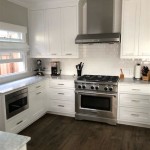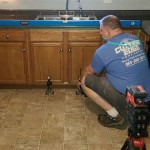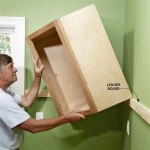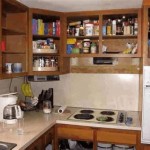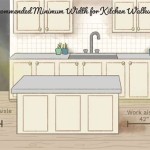What Causes Green Mold In Kitchen Cabinets
The presence of green mold in kitchen cabinets is a common problem encountered in households, impacting not only the aesthetic appeal of the kitchen but also potentially posing health risks. Understanding the underlying causes of this mold growth is crucial for effective prevention and remediation. Green mold, typically represented by species such as *Aspergillus* and *Penicillium*, thrives in specific environmental conditions commonly found within kitchen cabinets. These conditions primarily involve moisture, organic food sources, and inadequate ventilation. A comprehensive understanding of these factors allows for targeted strategies to mitigate the problem.
The article will delve into the principal drivers behind the proliferation of green mold in kitchen cabinets. It will examine how moisture accumulation occurs within these structures, the types of organic materials that serve as nutrient sources for the mold, the impact of poor ventilation, and the significance of identifying and addressing the root cause to prevent recurring issues. This exploration aims to provide homeowners with a detailed understanding of the factors contributing to green mold growth and potential methods for preempting it.
Moisture Accumulation: A Primary Catalyst
Moisture is unequivocally the most significant factor contributing to the growth of green mold in kitchen cabinets. Mold spores are ubiquitous in the environment, but they require a readily available source of moisture to germinate and proliferate. Kitchens, by their very nature, are high-humidity environments, especially when cooking, washing dishes, or using appliances that generate steam. This excess moisture can easily find its way into the enclosed spaces of kitchen cabinets, creating favorable conditions for mold growth.
Several sources contribute to moisture accumulation within kitchen cabinets. Leaks from plumbing fixtures, such as sinks, faucets, and dishwashers, are common culprits. Even small, slow leaks can provide a continuous supply of water, saturating the surrounding wood and creating an ideal habitat for mold. Similarly, condensation can form on cool surfaces, such as cabinet interiors, when exposed to warm, humid air. This is especially prevalent in cabinets situated near exterior walls, particularly during seasonal temperature fluctuations.
Spills of liquids inside cabinets are another frequent cause of moisture build-up. Whether it's from leaky containers of food or cleaning products, or simply accidental spills during food preparation, accumulated liquid provides immediate moisture to the cabinet surfaces. Furthermore, inadequate drying after cleaning can leave residual moisture behind, which can then contribute to mold growth. The porous nature of wood, commonly used in cabinet construction, readily absorbs and retains moisture, further exacerbating the problem.
The impact of moisture is amplified by the enclosed nature of kitchen cabinets. The lack of airflow hinders the evaporation of moisture, allowing it to persist for extended periods. This prolonged exposure to moisture, coupled with the presence of organic matter, creates a perfect storm for mold to thrive.
Organic Food Sources: Fueling Mold Growth
While moisture is essential for mold growth, the presence of organic matter provides the necessary nutrients for the mold to thrive and expand. Kitchen cabinets, particularly those used for storing food, are inherently prone to accumulating organic materials. These materials serve as a ready food source for mold, enabling it to flourish.
Food spills are a primary source of organic matter. Crumbs, spills of sauces, condiments, flour, sugar, and other food items accumulate within cabinets over time. These spills, often overlooked during routine cleaning, provide a rich source of carbohydrates, proteins, and fats that mold can readily consume. Even seemingly insignificant amounts of spilled food can sustain mold growth.
Another significant source of organic matter is dust. Dust, a ubiquitous component of indoor environments, contains a mixture of organic particles, including skin cells, pet dander, pollen, and insect debris. This organic dust accumulates within cabinets and provides a constant supply of nutrients for mold to feed on. The accumulation is often more pronounced in areas that are difficult to reach or are rarely cleaned.
The materials used to construct the cabinets themselves can also serve as a nutrient source for mold. Wood, particleboard, and other cellulose-based materials are all susceptible to mold growth. Mold enzymes break down the organic compounds in these materials, providing essential nutrients for its survival and propagation. This process can eventually lead to the degradation and weakening of the cabinet structure itself.
The presence of organic materials, combined with moisture, creates a synergistic effect that accelerates mold growth. The mold breaks down the organic material, releasing spores and expanding its colony. This process can quickly spread throughout the cabinet, leading to widespread contamination.
Inadequate Ventilation: A Contributing Factor
Ventilation plays a critical role in maintaining a healthy indoor environment, and its absence can significantly contribute to mold growth in kitchen cabinets. Adequate ventilation helps to regulate humidity levels, remove excess moisture, and prevent the build-up of stagnant air. Poor ventilation, on the other hand, traps moisture and creates a humid environment that favors mold proliferation.
The design of kitchen cabinets often contributes to poor ventilation. Cabinets are typically enclosed spaces with limited airflow. When moisture accumulates within these spaces, it readily evaporates, leading to high humidity levels. This elevated humidity, coupled with the presence of organic matter, creates an ideal environment for mold to grow.
Overcrowding of cabinets can also impede ventilation. When cabinets are packed with items, airflow is restricted, preventing moisture from escaping. This lack of airflow creates pockets of stagnant, humid air, fostering mold growth. Regularly decluttering and organizing cabinets can improve ventilation and reduce the risk of mold development.
Furthermore, the location of kitchen cabinets can impact ventilation. Cabinets situated against exterior walls, especially those facing north or east, are more prone to condensation due to temperature differentials. This condensation contributes to moisture accumulation within the cabinets. Ensuring proper insulation and ventilation in these areas can help mitigate this risk.
The use of exhaust fans during cooking and dishwashing is essential for removing excess moisture from the kitchen environment. However, if these fans are not used regularly or are not functioning properly, moisture can accumulate and eventually find its way into kitchen cabinets. Regularly maintaining and utilizing exhaust fans is an essential preventative step.
In summary, inadequate ventilation exacerbates the impact of moisture and organic matter, creating a conducive environment for mold growth in kitchen cabinets. Addressing ventilation issues through improved cabinet design, decluttering, and proper use of exhaust fans is crucial for preventing mold problems.

Causes Of Mold In The Kitchen And How To Avoid It Home Matters Ahs

Green Mold Identification Dangers Removal Prevention

What Is Green Mold And It Dangerous To Your Health

Is Green Mold Dangerous How To Remove

Mold On Furniture The Causes And Prevention Methods Environix

Mold On Furniture The Causes And Prevention Methods Environix

How To Prevent Mold In The Kitchen Ultimate Guide

What Is Mould And How To Get Rid Of It Axa

Causes Of Mold In Kitchen Cabinets Causesofmold Moldinkitchen Mol Tiktok

How To Remove Mold In Kitchen 100 Doable The Insider
Related Posts

